Nest vs Hive: Which is the best smart thermostat?
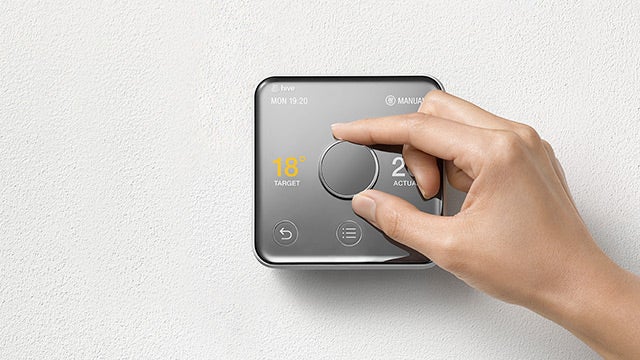
Nest vs Hive – Which smart thermostat should you buy?
Nest and Hive are the two most high-profile smart thermostats for anyone looking to heat their homes intelligently. We’ve reviewed the most recent versions, the 3rd-gen Nest Learning Thermostat and Hive Active Heating 2, so we can accurately compare the two to help you make the best choice.
Nest vs Hive – Design and Build
Nest has deservedly won praise for its designs, and the 3rd-gen Learning Thermostat is the best-looking smart thermostat we’ve reviewed. Its glass front and metal rim ooze class, and this is one thermostat that you’d be happy to have on the wall in full view.
Nest has made the design practical, too. The entire device twists, so you can adjust the temperature in an instant. Pushing in the thermostat activates the single button; using the twist and push actions, you can access the Nest’s menus and every feature.
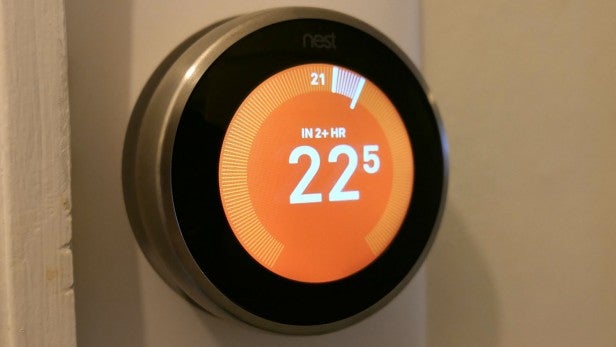
With Active Heating 2, Hive has made a huge improvement, too. While the original version looked old-fashioned and clumsy, the new Hive is far slicker and more attractive. Plus, it ships with different fascias so you can match the thermostat to your decor.
There are a few more buttons to play with in this version, but the Active Heating 2’s intuitive interface and main dial make it easy to adjust the temperature and get an at-a-glance view of the current settings. Nest remains the slightly more attractive device, but it’s fair to say that Hive isn’t far behind.
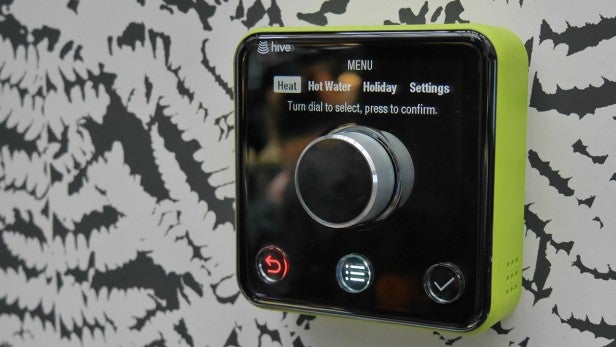
Nest vs Hive – Features and Installation
Hive and Nest can’t be 100% precise about every boiler they support – there are a whole lot of boilers out there – but there are decent guidelines to follow. Hive says that any working gas or LPG heating system is supported, as well as some electric boilers. It suggests contacting the company if you have an oil boiler to find out if your system is suitable. Hive will work with some underfloor systems, but not those that rely on electricity.
Nest says its system works with the following:
- Combi and condensing boilers
- System and heat-only boilers
- Hydronic underfloor systems
- Air-source and ground-source heat pumps
- Switched live systems
- Low-voltage dry-contact systems
Generally, though, compatibility should be similar between the two systems, since it all hinges on the one component that ‘talks to’ the boiler. Hive calls it a ‘Receiver’, while Nest refers to it as a ‘Heat Link’. The thermostat controls this box to control your boiler, with both devices supporting heating and hot water.
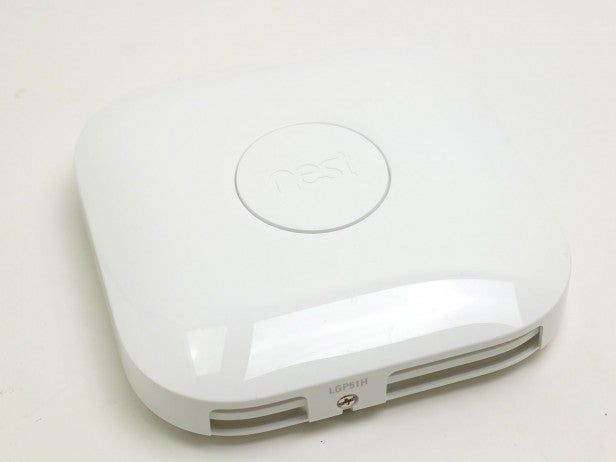
Nest’s thermostat has two installation options. First, you can plug it into a wall socket and use the provided stand; or you can replace a wall-mounted thermostat and use the existing wiring. Hive Active Heating 2 is a little simpler, with four AA batteries powering the thermostat. This makes placement easier; you can put the thermostat on any wall that you like. Hive quotes battery life at around two years.
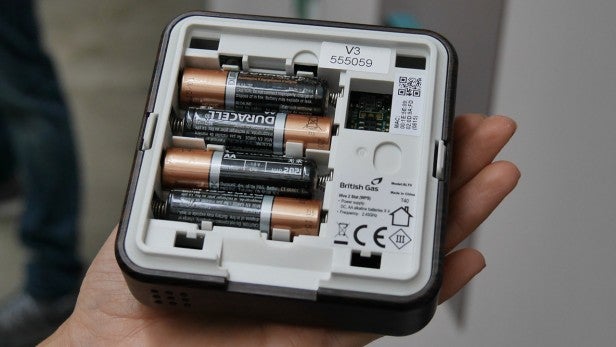
Both devices can be self-installed if you’re a competent DIYer. If not, you’ll need to opt for a professional installation. With the Hive, you can buy a package that includes installation by an engineer; with Nest, you’ll need to find your own heating engineer – the company does have a network of engineers listed on its website.
Nest is the easiest system to program, and the word ‘Learning’ in its name explains why. Rather than having to set your schedule, Nest learns over time how you like your home and configures its own schedule. Hive is a more traditional product, in that you have to set your schedule manually. The app makes this easy to do, at least. If you’re happy to control everything manually, then with the Hive you can be up and running pretty quickly.
Both Nest and Hive offer presence detection, enabling the systems to turn off your heating when you’re out and turn it back on once you return; they use your phone’s GPS to detect your actual location. This can lead to huge savings, as you don’t have to heat your house unnecessarily.
Nest also integrates a sensor into the thermostat that can detect motion and show useful information on the high-resolution display, such as a clock or the current temperature. The sensor in the 3rd-gen thermostat operates at greater range – it’s called Farsight – and it’s a neat way to make the thermostat that little bit more useful.
Both systems have a holiday mode, too, and Hive 2 now supports multi-zone homes in a similar way to Nest – the first version didn’t.
Nest vs Hive – Performance
Both products worked accurately for us, heating our homes when we were in and turning the heating off when we were out. With the smartphone apps, we found that both systems were easy to control from anywhere, too. Arguably, Nest has the slicker app of the two, though.
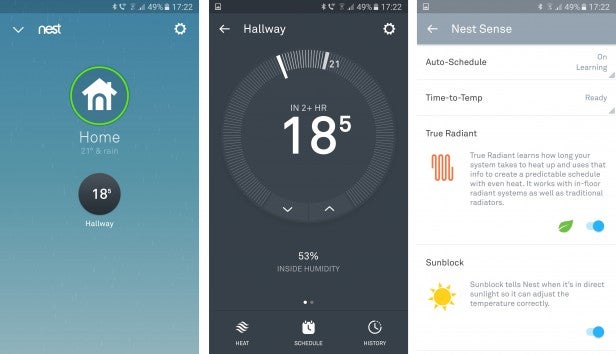
Nest’s automatic schedule configuration can be a bit hit-and-miss at the start, while it’s learning exactly how you use your home. Hive Active Heating, with its manual schedule, works better immediately, but it can’t improve automatically and you’ll most likely need to tweak settings manually.
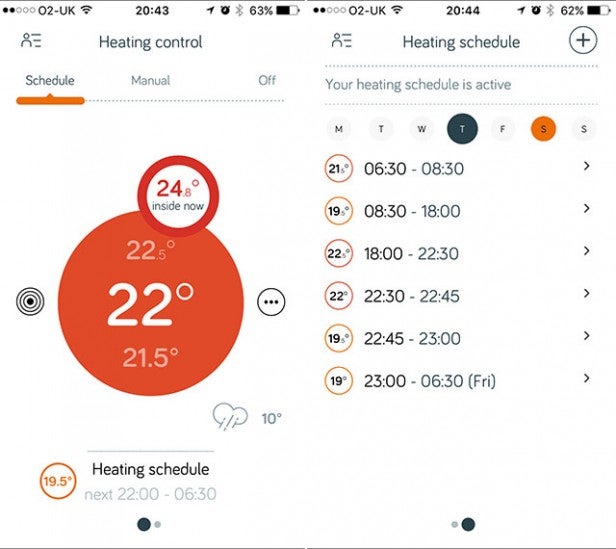
Neither product offers an individual radiator control option via smart thermostatic radiator valves (TRVs). Honeywell’s Evohome does this, helping you to save even more money by only heating the rooms you’re using. Other systems are providing smart radiator thermostats as on option, such as with the recent Tado Smart Radiator Thermostats.
Nest vs Hive – IFTTT and other Smart Home Tech
Nest and Hive both have fully featured IFTTT channels, so you can automate your heating based on input from other devices. For example, you can turn on your heating when you’re on the way home, or turn off your heating when a set outside temperature is reached.
Nest has a significant advantage with its Works With Nest system. This provides similar controls to IFTTT, only smarter and faster. For example, Nest can detect when you’re out and turn off your Philips Hue lights. Intelligently, Nest can turn your Hue lights on and off to make it look as though you’re home if you’re not.
There are hundreds of Works With Nest products, with support from Philips Hue, Misfit, WeMo and more. All rules are configured through the original manufacturer’s app. Nest also doesn’t offer direct control of third-party devices from its app. In this way, Nest doesn’t unify your smart home products in quite the same way as Samsung SmartThings.
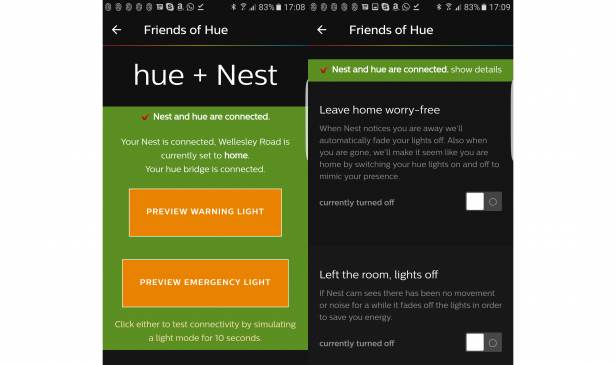
Hive doesn’t have the same integration with third-party products, but it does have its own growing range of Hive-branded smart home devices, including motion sensors and the new Active Lights. All devices are controlled from the Hive app, but they’re not as flexible as buying third-party devices.
For example, Active Lights can only be controlled via the app or a Hive sensor, but there are no dedicated switches at the moment, which Philips Hue has. On balance, Nest has the advantage since it offers tighter integration with third-party products.
Nest vs Hive – Alexa and Siri
Nest and Hive both have great Alexa Skills, so you can control your heating with your voice using an Amazon Echo. Neither has support for Apple’s HomeKit – and it isn’t trivial to add this, either. HomeKit requires a encryption chip to work, so you’d have to buy new hardware. If you want Apple support, then you’ll need a Netatmo Smart Thermostat, Honeywell Lyric or, soon, Tado Smart Thermostat with a V3 internet bridge.
Nest vs Hive – Price
Pricing is similar for both systems, although Hive has two options. You can either pay £180 and self-install, or, if you’d rather have a professional do the job, you can buy the kit with installation bundled for £249. Nest is only available standalone, and costs £199. You’ll either need to fit it yourself or pay a professional: the cost of a typical installation is likely to cost between £50 and £100. This makes Nest a little more expensive.
Nest vs Hive – Which one should I buy?
It’s a tough decision, since both products are great ways of making your heating smart, and offer a similar array of features. They’re both well priced and look great, too.
Nest has the slight edge in that its learning algorithm should make for smarter scheduling over time, and Works With Nest brings support for other smart home kit. Hive’s own-brand smart home products extend what the product is capable of, but they’re not quite as good as third-party alternatives.
For full room-by-room control, neither product quite cuts it. Here, the more expensive Honeywell Evohome is the better product.


